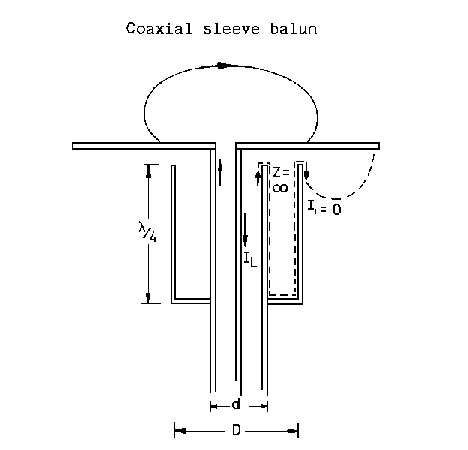
The sleeve balun does not give any impedance transformation; it is a 1:1 balun. This is fairly easy to achieve at VHF. All that is required is a tube that is coupled to the outer of the coax at approximately 0.93 X l/4 from the antenna feed point.

The ratio D/d should be around 2.5 to 4. The open end of the tube facing the antenna element should be as close as possible. In effect this tube is a shorted l/4, at it open end the impedance looking back down the coax is high, thus preventing RF current developing on the outer of the coax.
I have made sleeve baluns using 15 mm copper water pipe and soldering a 'Free socket N' type connector onto it. The l/4 may be less than that of free space l/4, because of the close proximity of the outer tube to the coaxial cable. I found that 468 mm seems to work OK at 2 m, when using RG213 or URM 67.
You will have to use good quality silver-plated ' N types ' to make soldering easier, and I used a plumbers blowlamp to make the soldered joint.
First I cut the 15 mm copper pipe with a pipe cutter which gives a perfect clean cut end to the tube. Then I disassembled the in-line socket; the threaded nut where the cable enters the plug has to be soldered to the 15 mm tube. Make sure the copper tube and the nut are very clean, I use fine wire wool to do this and then I apply a thin layer of flux. Next line up the tube on top of the nut, this is made easier if you can clamp the tube vertically and seat it up against the back of the cable-retaining nut. I have a drill stand and found that this did the job for me. I have a piece of fireproof material under the nut and tube assembly. All you have to do then is apply some heat and run in a bead of solder around the nut and the end of the tube.
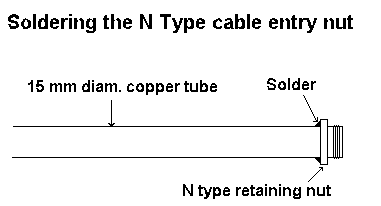
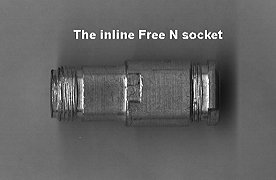

When it's cooled down, clean off any flux and you are ready to assemble the free socket in the normal way feeding the coax down the 15 mm tube. The free end of coax will connect to the antenna, so dependent on the box arrangement the antenna feed point has, determines the way you weather proof the connection and the open 15 mm tube.
Flexible version of the sleeve balun
(As shown in The UHF Compendium Part 1 and 2)
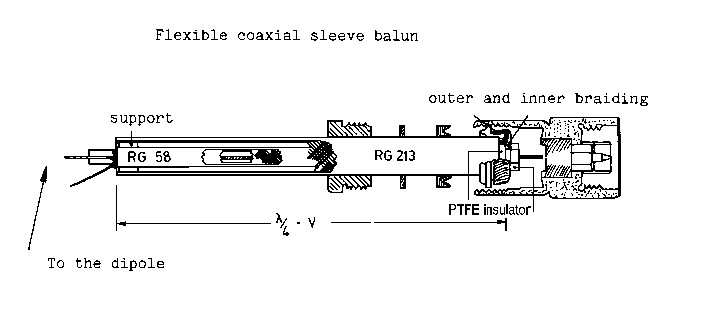
Occasionally space limitations etc. do not allow a stiff assembly. For
these cases a coaxial sleeve balun composed of RG58 coaxial cable and
parts of the RG213/U cable (external insulation and screening mesh) was
fabricated. It is a simple matter to remove inner conductor and
dielectric from RG213/U or German video cable (designated 1,1/6,6 75
Ohm). The complete assembly may be mounted to a plug connector. The
result is a flexible coaxial balun that may be screwed onto the antenna
feeder.
To make such a balun, start with a 14 cm long piece of RG213/U from which
inner conductor and dielectric have been removed. A 19 cm long piece of
RG58/U is threaded into this sleeve and wrapped with insulating tape
1 cm off the end facing the plug until it fits tightly inside the sleeve.
Attach the plug according to the procedure for RG213 cable. The
critical part is the slim insulation of the internal conductor of the
RG58 which should be supported by means of a 3 mm thick disc of PE
(internal insulation of RG213) prior to soldering to the spigot of the
plug. The hole in the disc should be opened up with the aid of a 4 mm
drill.
The sleeve of the remaining 4 cm of the RG58/U is removed at the exit.
The inner conductor with its insulation is pushed through the coaxial
screening. This end is centred by means of insulating tubing and
sealed against moisture by means of shrink-on sleeve. Shrink-on sleeve
and cable sleeve should first be covered with contact adhesive. The
adhesive should have dried before applying open fire to the thermo-
shrinkable tubing to avoid any risk of fire.
The physical length of the balun sleeve is calculated according to the
following equation:
This diagram shows a cross section of the various dielectric layers of
the quarter wavelength coaxial sleeve balun.
Screening RG58 = ri = 3.6 mm
RG213 = ra = 7.25 mm
Sleeve RG58 = r1 = 4.95 mm
Approximately 3 cm of RG 58 are wrapped with tape for centring purposes
(E r = 3.5).
The velocity factor V = 1/SQR (E) for PVC is 0.53
The remainder of l/4(electrical) = 17.5 cm - 3 cm (tape) = 14.5 cm has a
V = 1/SQR (Erw) = 1/SQR (1.49) = 0.82
0.53 x 3 cm =1.59 cm
0.82 x 14.5 cm = 11.88 cm
Total length = 13.47 cm



The Open Balun
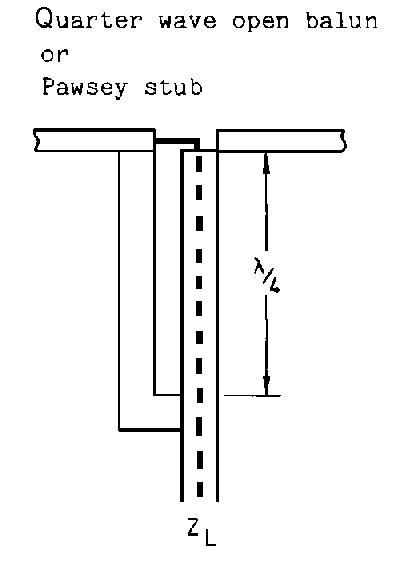
This method of forming a 1:1 balun is sometimes easier to make although it is not quite as good as the tube sleeve balun.